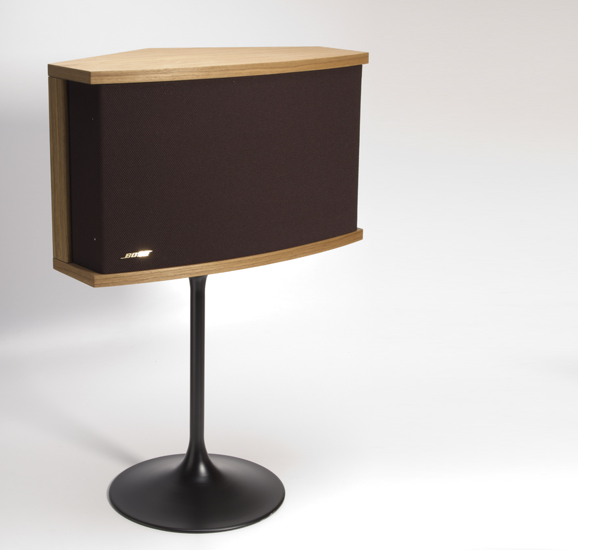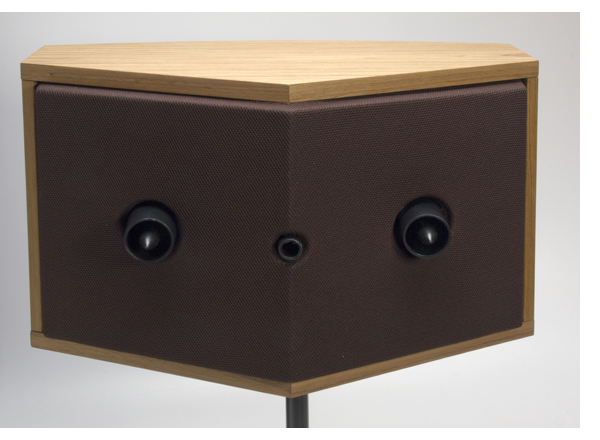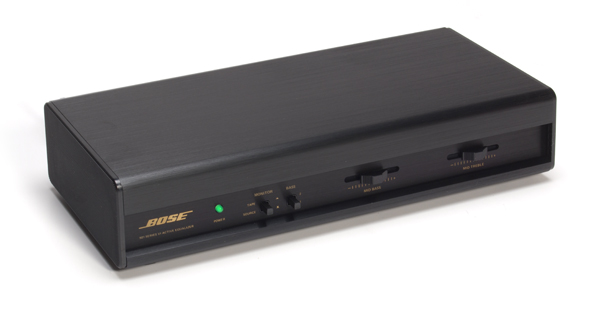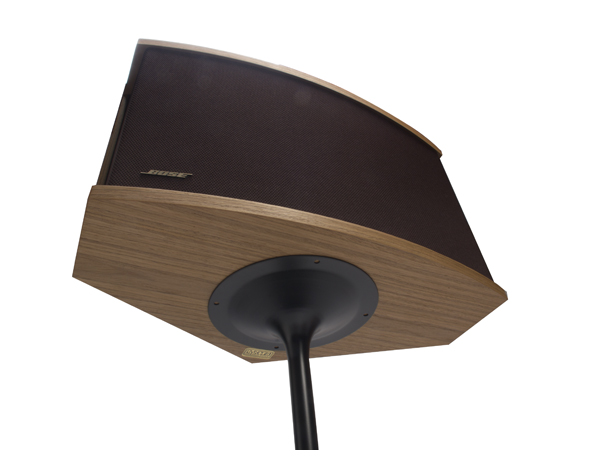We Review the Bose 901… Magic or Myth?
By Jeff Dorgay
Part One
“No highs, no lows, it must be Bose.” And so the story goes in the wubbulous world of high-end audio. Other than using a green sharpie to get better CD sound, or that guy that calls you on the phone and osmotically makes your system sound better, no greater myth exists in audio today than that of the Bose 901 speakers. Much like Bigfoot, have you even seen a pair of Bose 901 speakers or, better yet, heard them?
Lately, I’ve had several positive encounters with Bose products. My Fiat 500 Sport has a Bose sound system, and yes, it possesses admirable bass extension (so there!) and a wide stereo image from the driver’s seat. I also experienced Bose on a recent trip home from Spain, where I sampled the new Burmester sound system in the latest Porsche 911 Cabriolet, and Porsche was kind enough to fly me home first class. The latter experience came with a pair of Bose Noise Canceling headphones (another product I’d never actually used, but about which I heard plenty of scuttlebutt). I must say, the noise-canceling effect works incredibly well; the first six episodes of “Californication – Season 5” flew by.
The ‘phones claimed decent sound quality and, compared to the little bit of ultimate fidelity they gave up to my $600 IEMs, were worth the noise-canceling effect. I’m thinking of investing in a pair before my next European trip. So that’s two strikes in Bose’s favor.
As TONEAudio is currently running a contest to identify the biggest audiophile myths, I began pondering: How do Bose 901s actually sound? My last memory of the speakers harkens back to a jazz club in my hometown of Milwaukee that actually had the speakers installed into the ceiling by their pedestal bases and powered by a Marantz 4300 quad receiver. Another area venue had their ceiling-mounted 901s powered by a large stack of McIntosh gear. Both systems were pleasant. Not to be outdone, another bar owner installed Magnepan MGIIs from the ceiling, which, coincidentally, ended up being destroyed by a ruckus started by the Milwaukee Rugby Club after a hearty victory. And so it goes.
Double Standards
Good memories aside, if you ask any audiophile, they will unequivocally tell you how much Bose speakers suck, and give you a million reasons why the speakers they own are much, much better. If you dig deep enough, chances are good at least one of these opinionated individuals owns either a pair of Rogers LS3/5as that don’t produce much bass or even a pair of smaller Magnepans. Sure, I love my Maggie 1.7s, but they don’t produce a lot of bass, either, and really need a lot of juice to give their best performance. And don’t even get me started on single-driver Lowthers. Been there, done that, too.
Now, to further the conversation, ask such expert audiophiles if they have actually heard a pair of contemporary 901s. Are you thinking mythbusting? Me too.
This multi-part article will be a standard review in the sense that we will listen to the Bose 901 speakers in a few different rooms and use a wide range of amplification— from a Pioneer SX-424 vintage receiver all the way up to a full stack of Audio Research Reference components—just as we would with any other speaker evaluation.
And conspiracy theorists, take note. I bought a random pair of 901s via the Web for retail price. I initially tried to contact Bose to see if we could get a review pair, but no one at the PR department would return my call. Hence, there will be less historical data accompanying the review, which is unfortunate, as the speaker is now on its sixth iteration of development and changed somewhat since its introduction in 1968.
Seeing that Bose is a $2 billion-per-year company, it’s doubtful any manufacturer other than perhaps Vandersteen or Magnepan has produced more quantities of a same speaker model. Unless we get a phone call, this will remain an unresolved question.
Service: Ambiguous to Excellent
A quick call to the Bose store at the local mall reveals that the 901s are “not a regular stock item.” But the sales person tried his hardest to switch me into a top-of-the-line Wave Radio, telling me “no one has big speakers in their home anymore.” He then acquiesced. If I must have a pair of 901s, I can special order them or go directly to the Web site. I do the latter, and about 90 seconds after getting to the home page, a pair of walnut 901s with pedestal bases is on its way. Six days later, the 901s arrive on my doorstep, safe and sound.
So far, so good. The speakers look to be in perfect shape and their fit and finish is excellent for $1,400. At the moment, Bose rates an A+. Next, the listening begins. Will the speakers fall off their pedestals? Stay tuned for Part Two.
Part Two

Setup and Installation
My pair of 901s is set up in the classic fashion on the cool, black metal pedestals that resemble something from the Herman Miller furniture catalog, circa 1960. An Eames lounge chair and an old copy Playboy is all that’s required for the full-on Austin Powers effect. Groovy, baby!
At 35 pounds each, the speakers are easy to manage. However, using them with the metal bases requires wood screws. While the holes are predrilled, you probably won’t utilize them more than a couple times without causing permanent damage to the speaker base. I can’t imagine a company as large as Bose wouldn’t be able to add threaded inserts without raising cost.
The binding posts allow for any kind of speaker cable. Yet if you are considering using your 901s with any kind of upgraded cable, don’t permanently attach the bases until you make a cable commitment. I employed Radio Shack’s 16-gauge speaker wire for the majority of listening sessions.
I used two systems to evaluate the speakers. The first consists of a vintage Pioneer SX-424 with a stock SL-1200 turntable/Grado Red cartridge and a third-generation iPod Classic, modded by Red Wine Audio. The second involves the Sooloos Music Server feeding Wadia’s new 121 decoding computer to the Unison Research S6 vacuum-tube amplifier. At the very end of the sessions, the Pass Labs XA200.5 monoblocks were employed to see just how loud the 901s could play.
Speaker Placement
Much like a pair of Klipschorns, the Bose 901 lends itself to corner placement. Because the majority of the drivers face rearward, placement is the key to fine-tuning the imaging performance.
Putting the speakers closer to room corners exaggerates the reflection and yields the overblown stereo image that perhaps contributed to the popular misinformation associated with Bose. If you are used to the sound of traditional box speakers, 901s—when tightly placed in room corners—sound much larger than life and boast an exaggerated soundstage. They feel like the remnants of a hallucinogenic experience. The 901s’ modest size encourages experimentation, which proves equally successful in my smaller 11 x 17-foot living room as well as in my 16 x 25-foot dedicated room.
My favorite listening position with the 901s seems counterintuitive albeit more traditional in an audiophile sense. Placed about eight feet apart, eight feet from a couch, and about five feet out into the listening room appeared perfect, and allowed the sound from the front-firing driver to anchor the presentation. Exactly like every panel speaker I’ve used in the room, the 901s were much more interesting on the long wall.
 The EQ Box and The Moment of Truth
The EQ Box and The Moment of Truth
Because the Bose 901 makes use of nine full-range drivers, it takes advantage of an inline equalizer to make the speakers sound the way they are intended. Traditionalists, before you cry foul, think of the popularity of DSP-based speakers these days. Bose achieves a similar, if less sophisticated and considerably less-expensive effect with a passive EQ. The manual states the EQ can be used with series V 901s, but earlier models require the proper box.
If you are using a receiver, the EQ must be placed in a tape-monitor circuit, or between amp and preamp if you have separates. The supplied pair of three-foot RCA patch cords gets the ball rolling. The EQ features a two-position button: position one offering a flatter response, and position two adding a slight bass bump, not unlike the loudness button on a 70s receiver. Finally, there are two sliding controls for mid-bass and mid-treble, the latter claiming the most control over the overall tonal balance.
Slightly Rolled off Highs and Pretty Solid Bass
When set up like a conventional pair of smaller monitor speakers, the 901s produce a sound much like the original Magnepan MGIIs. Fortunately, audio pack rat and contributor Jerold O’Brien still has a mint pair of MGIIs to which I listened for direct comparison. Sure enough, they enjoy a softer, more relaxed high-frequency response, just like the 901s. The current MMG we reviewed possesses a bit more treble extension than the original MGIIs, but does not throw as large a soundfield. And, both Magnepan models need a ton of power to get up and go.
Where in semi-nearfield the 901s produce a wide soundstage, they also cast an excellent stereo image. A suite of Joni Mitchell tunes from Court and Spark, Hissing of Summer Lawns, and Don Juan’s Reckless Daughter captures her voice in the same approximate place as it’s found in my reference system. Sampling a wide range of solo vocalists reveals the importance of the mid-treble slider. Push too much for treble brightness and the vocals become grainy—not unlike when adjusting toe-in with a conventional speaker.
Thanks to their wide dispersion and massive soundstage, the 901s excel playing live-recorded music. Ted Nugent’s “My Love is Like a Tire Iron” from Intensities in Ten Cities equates to an impressive experience when cranked to brain-damage levels. Nugent’s band is spread-out between and beyond the speaker boundaries, and never diminishes in intensity when I get up off the couch to grab another beer. These speakers rock.
Those questioning the bass, look no further than the Stereophile test CD. 50hz tones were reproduced solidly, with plenty of energy on the 40hz track, though things dropped off pretty significantly beneath 40hz. A quick listen to a handful of bass heavy tracks from Pink Floyd, Genesis and Yello proved highly convincing and again, way more powerful than a number of small stand mounted speakers that I’m very familiar with.
Advantages of a Single Speaker Design
The essentially crossoverless design gives the 901 an unmistakable coherence, the model’s greatest strength. Its incredibly wide dispersion comes in a close second. The Bose 901s sound great anywhere in the room, and what you might give up in terms of ultra-focused, sweet-spot listening, you’ll gain in spades when you have a room full of people. These could very well be one of the world’s three or four best party speakers. Again, compromise: Would you like a pair of speakers that you just listen to in your listening chair for private sessions, or do you do most of your listening in secondary mode while hanging out in the house cooking and entertaining?
No doubt, some graininess sneaks into the midband because the EQ box isn’t chock full of Mundorf capacitors. That said, have you ever taken a peek at the crossover of your choice $1,400 speaker? Precious few include components sporting any better quality.
After extensive listening, the Bose 901s strike me as being damn good. They have some limitations, but don’t all $1,400 speakers? For that matter, what $10,000 speakers are perfect? I’ve heard a handful of speakers that check a couple more audiophile boxes than the 901s, but I’ve heard many more that sound much worse. Much as I hate audiophile clichés, the “sins of omission” has never been truer than with these speakers. They are so smooth and musical, it’s tough to freak out about the missing detail.
And that’s the area in which the 901 lacks: reproducing low-level detail and microdynamics. When the keyboard enters the first verse of Joni Mitchell’s “Trouble Child,” it’s subdued, as are the bongos at the beginning of “Jericho.” Again, I suspect information is lost in the EQ and through the stock cables. What the 901s sacrifice here, they make up for on a broader scale via the ability to play really loud and without strain.
The 901s cruise while being played at volumes well beyond those that would reduce mini monitors to rubble. Turning up Ace Frehley’s “Genghis Khan” from Anomaly at a level that hits 100 db peaks proves effortless.
Am I Nuts?
For those that think I’ve lost my marbles, I’ve played in every corner of the audiophile sandbox. Other than plasma tweeter designs, I’ve had my hands on almost everything over the past 35 years. Long-time TONEAudio readers know I have a soft spot for panel speakers (full range ESLs, in particular) and single-driver/SET systems. The 901s share many of the similarities that make enticing the latter types of speakers, and come with few of the limitations. Quad 57s are more beguiling through the midband, the MartinLogan speakers carry more extension at both ends of the frequency spectrum, and the Magepans lie somewhere in between. But they cost more and present greater challenges to a room and system.
Like any other “audiophile” speaker, the Bose 901 provides less-than-optimal results if setup is executed without care. I found the most lifelike sound came via a configuration slightly counterintuitive to that suggested by the manual.
The Bose 901s are equally highly musical and easy to listen to for hours without fatigue, characteristics many other speakers fail to deliver. Indeed, my audiophile buddies that I bribed into my listening room with IPAs are still shocked at just how good the 901s sound. As my wife likes to say, “What if Bigfoot is really a nice guy?” Consider this myth busted.
To make this conclusion as perfectly clear as possible and stave off any confusion: A handful of speakers in the $1,400 range reproduce music more accurately than the Bose 901. But—and like Pee Wee Herman likes to say, “Everyone has a big but”—the 901 gets the essence of the music right. The crossoverless design does a fantastic job with pace, which is what always draws me to single-driver and full-range electrostatic designs.
The ease with which it yields solid results makes the Bose 901 very attractive to both the normal music lover and budding audiophile. Mix the Bose 901s, a $150 vintage receiver, and an iPod, and you’ve created a rocking system. Add a better source and substitute a great tube integrated, and you’ll be shocked at the sheer musicality of the combination.
Yes, every speaker design involves compromise. Considering that this model is aimed more at the mass market than the audiophile, the 901s possess more than enough virtue to be considered an excellent value. They are certainly one of the most fun speakers I’ve had the pleasure to hear. Isn’t that what this is all supposed to be about?
The third and final installment to this trilogy will include listening results with alternate cable placement, changes to the reference system and speaker placement options. So forget all the folklore you’ve heard about the Bose 901s, these are serious speakers. I’m seriously considering keeping the review pair for my beach house – they will fit right in with the Eames Lounge chair and Noguchi table.
Part 3: Epilogue
After listening to the Bose 901s for a couple of weeks, I remain convinced they offer good value for the price and are incredibly user-friendly. But how do they respond to the usual tweaks applied by audiophile to practically every other speaker?
Premium Components
While the 901s offer a more diffuse soundfield than many speakers, they have enough resolution to tell the difference between a vintage or mass-market receiver—as well as more upscale units, though, at a certain point, the contrast becomes fruitless. For example, it’s very easy to note the variation between the Pioneer SX-424 and Cambridge 740 amplifier, as well as the distinction between tube and solid-state amplification.
Stepping up the cable quality from standard Radio Shack 16-gauge wire also pays dividends in upper-midrange clarity and high-frequency extension—both priorities. Swapping the 16-gauge wire for a $199 pair of AudioQuest Rocket 33 speaker cables, and the supplied RCA patch cords for two pairs of $39 AudioQuest Copperhead interconnects, brings greater focus to the overall presentation.
 Ah, the Pedestals
Ah, the Pedestals
Even if the Bose 901s do not use a tweeter, per se, it’s to your advantage to get them up higher for critical listening than the height provided by the standard 18-inch pedestals; the manual specifies 18-36 inches as optimal. Again, just as a traditional speaker benefits, the 901s profit from solid speaker stands that are spiked at the bottom.
A few spots of blu-tack between the speakers and a pair of 24-inch Sound Anchor stands up the game, yielding tighter and more resolute bass response as well as a greater sense of pinpoint imaging across the soundstage. The Sound Anchor stands also make it much easier to take advantage of upgraded speaker cable, as it must travel down the center of the Bose pedestals. Those planning on using audiophile-vetted cable will have to get handy with a large drill bit to modify the stands. There’s no way you can pair Nordost Odin speaker cable with the 901s and the stock pedestal stands. Don’t even think about it.
Backwards Listening
A number of Bose enthusiasts enjoy listening to 901s “in reverse,” allowing the eight drivers mounted on the rear of the cabinet to face the listening position. My spirit of investigation encouraged this tact, but it was not my favorite position. There’s slightly more HF extension, but the big, expansive soundfield that makes the speaker so enticing simply disappears.
Final Thoughts
That’s my adventure with the Bose 901. These speakers have been a blast to listen to with every kind of music. While they yield decent performance with a low-budget receiver, they are worthy of journeyman-level components and a modest cable upgrade. Advanced hobbyists could probably uncover even more performance by modding the EQ’s passive components, but doing so is well beyond the scope of this review and definitely voids the warranty.
Bigfoot may still be lurking in the shadows (the rumor suggests he is in upstate Washington somewhere near the Canadian border), but the Bose 901 speakers are only a couple of mouse clicks away. Do it.



